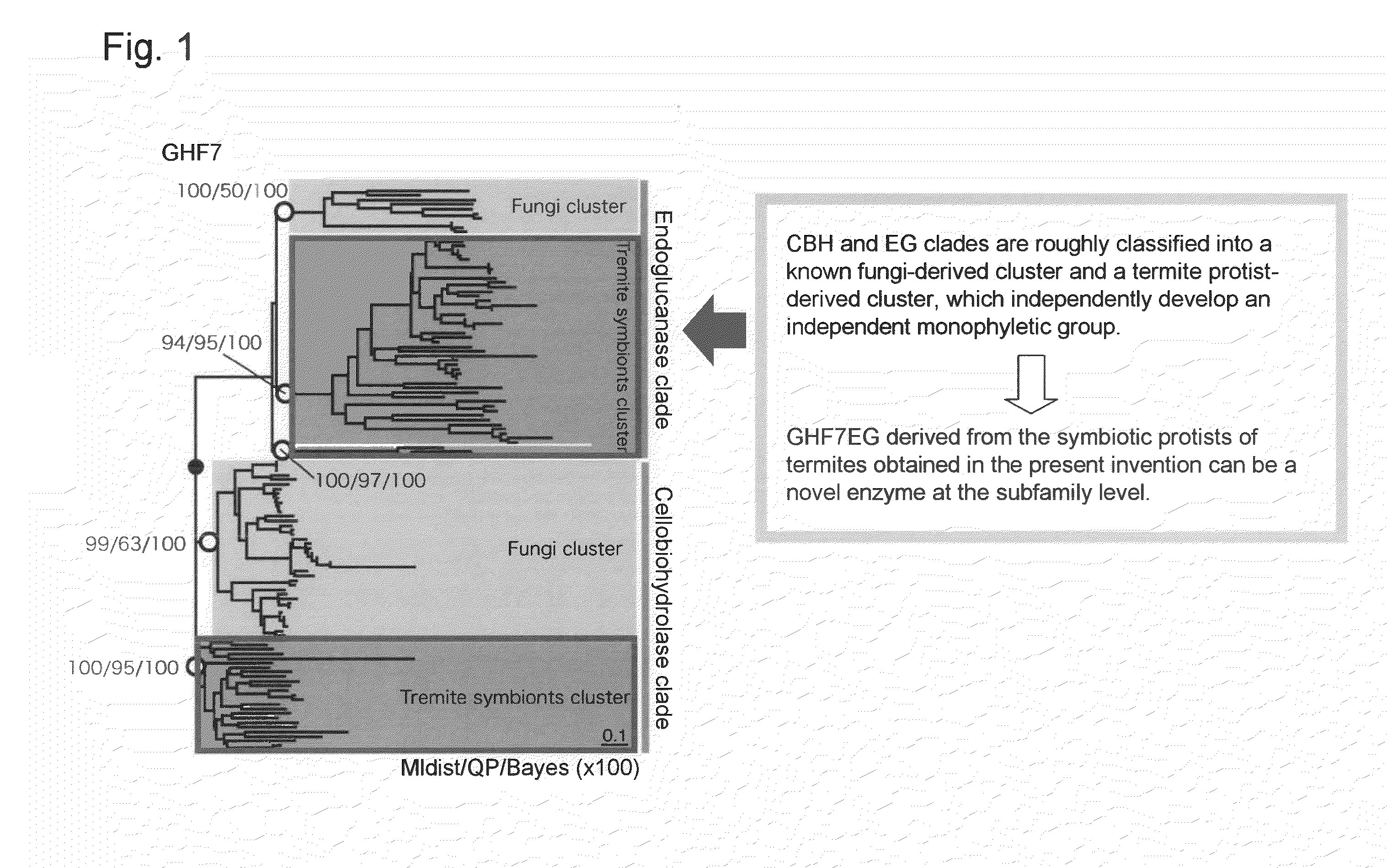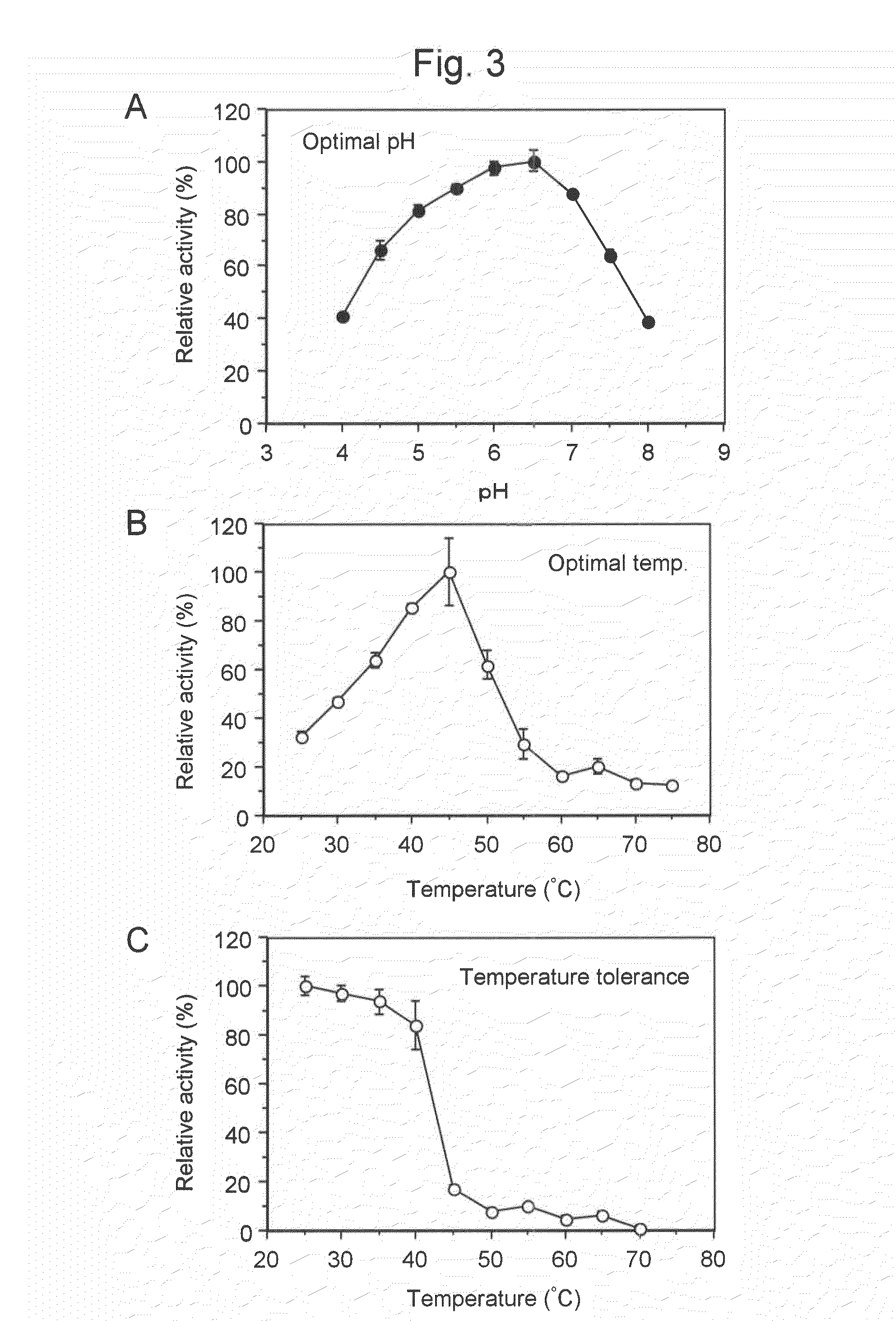Cellulase enzyme and method for producing the same
a cellulase and enzyme technology, applied in the field of cellulase enzymes, can solve the problems of difficult culture of symbiotic protists, high cost, and inability to achieve the effect of reducing cellulosic biomass
- Summary
- Abstract
- Description
- Claims
- Application Information
AI Technical Summary
Problems solved by technology
Method used
Image
Examples
example 1
Isolation of mRNA
[0073]The intestinal tracts were extracted from Reticulitermes speratus, Hodotermopsis sjostedti, Neotermes koshunensis, Mastotermes darwiniensis, and Cryptocercidae, the extracted intestinal tracts were individually disrupted in Solution U (Trager 1934, Biological Bulletin, Vol. 66: 182-190), and the resultants were filtered through a 100-micron nylon mesh. The obtained suspension was mildly centrifuged at 100 g for 3 minutes to obtain protists fractions. The fractions were washed three times with Solution U to obtain protists fractions for RNA extraction. mRNA was isolated in accordance with the instructions of Oligo-dT30 (Roche, Japan), from protists of the host termites.
example 2
Construction of cDNA Library
[0074]2-3 μg mRNA, which was prepared from the symbiotic protists of the termites, was used to construct a cDNA library. A Reticulitermes speratus library was constructed in accordance with the method of Piero et al. (Carninci, P. & Hayashizaki, Y., 1999, Methods Enzymol. 303: 19-44), and libraries originating from other termites were constructed in accordance with the method of Sugano et al. (Maruyama, K. and S. Sugano, 1994, Gene 138 (1-2): 171-174). The Reticulitermes speratus cDNA library was subcloned into plasmids using the E. coli SOLR strain and the ExAssist helper phage (Novagen) in accordance with the instructions.
example 3
[0075]The obtained E. coli clones were cultured in LB medium and purified using a MultiScreen FB (Nihon Millipore) in accordance with the appended instructions. With the use of purified plasmid DNA, the sequences of 917, 920, 1056, 1023, and 921 library clones derived from the symbiotic protists of Reticulitermes speratus, Hodotermopsis sjostedti, Neotermes koshunensis, Mastotermes darwiniensis, and Cryptocercidae were determined using a Big dye terminator cycle sequencing kit v 3.1 and an ABI3700, 3100, or 3130 automatic sequencer (Applied Biosystems) in accordance with the conventional technique. The single pass sequences at the 5′ ends were determined using the M4 primer (SEQ ID NO:141: 5′-GTT TTC CCA GTC ACG AC-3′). The obtained sequences were subjected to homology analysis via FASTX relative to known sequences accumulated in public databases (DNA database Japan), and annotation was carried out. From among the resultants of annotation, those corresponding to cel...
PUM
| Property | Measurement | Unit |
|---|---|---|
| temperature | aaaaa | aaaaa |
| pH | aaaaa | aaaaa |
| pH | aaaaa | aaaaa |
Abstract
Description
Claims
Application Information
 Login to View More
Login to View More - R&D
- Intellectual Property
- Life Sciences
- Materials
- Tech Scout
- Unparalleled Data Quality
- Higher Quality Content
- 60% Fewer Hallucinations
Browse by: Latest US Patents, China's latest patents, Technical Efficacy Thesaurus, Application Domain, Technology Topic, Popular Technical Reports.
© 2025 PatSnap. All rights reserved.Legal|Privacy policy|Modern Slavery Act Transparency Statement|Sitemap|About US| Contact US: help@patsnap.com



